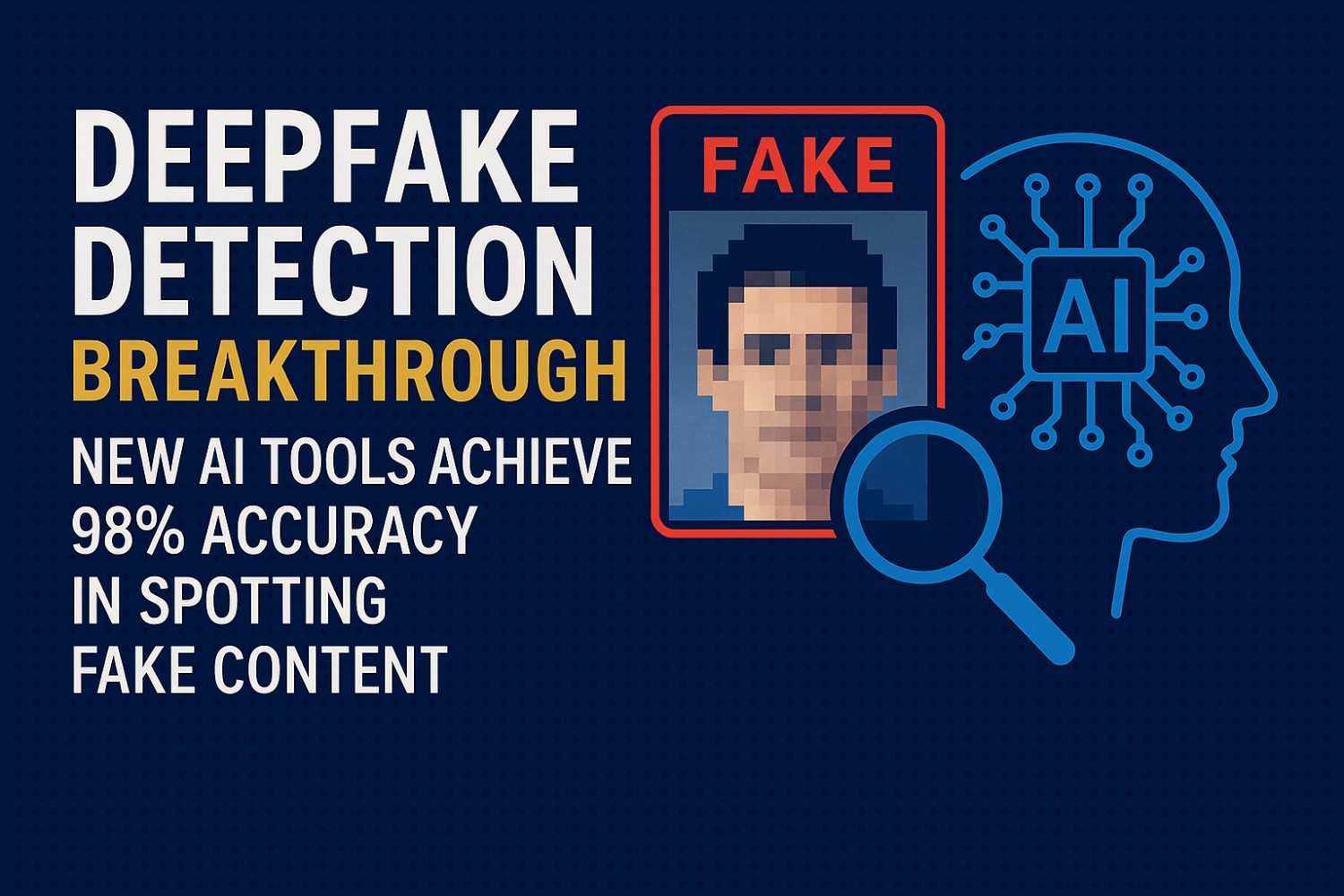Imagine getting a video call from your boss asking you to transfer $50,000 urgently. The voice sounds exactly right, the face looks perfect, and even the mannerisms match. You comply immediately. Later, you discover it was a deepfake scam, and your real boss never made that call. This nightmare scenario happened to a Hong Kong company that lost $25 million to deepfake fraudsters in 2024.
But there’s hope on the horizon. Scientists have just achieved a major breakthrough in fighting these digital deceptions.
The Game-Changing 98% Accuracy Milestone
In August 2025, researchers unveiled a universal AI detector that can identify deepfake videos with an astounding 98% accuracy across different platforms and content types. Unlike older detection tools that only worked on specific types of fakes, this new system can spot both synthetic speech and facial manipulations with unprecedented precision.
This represents a massive leap forward in our ability to distinguish real content from AI-generated fakes. The tool is already being evaluated for deployment in media organizations and law enforcement agencies worldwide.
What Exactly Are Deepfakes?
Deepfakes are AI-generated videos, images, or audio recordings that replace a person’s likeness with someone else’s. The technology uses sophisticated machine learning algorithms to analyze thousands of photos and videos of a target person, then creates convincing fake content.
The name “deepfake” comes from combining “deep learning” (the AI technique) and “fake.” While the technology started as a novelty for entertainment, it has quickly evolved into a serious threat.
Why Deepfakes Are So Dangerous
The rise of deepfake technology poses several critical risks:
Financial Fraud: Criminals create fake videos of executives or family members to trick people into transferring money or revealing sensitive information.
Political Manipulation: Fake videos of politicians saying things they never said can influence elections and destabilize governments.
Personal Attacks: Innocent people find themselves in fabricated compromising situations, leading to harassment and reputation damage.
Relationship Scams: Dating apps and social media are flooded with fake profiles using deepfake photos and videos to deceive potential victims.
How the New Detection Technology Works
The breakthrough detection system uses advanced machine learning algorithms that analyze multiple aspects of video and audio content simultaneously. Here’s how it spots fakes:
Micro-Expression Analysis
The system examines tiny facial movements and expressions that are extremely difficult for AI to replicate perfectly. Even the most sophisticated deepfakes often miss subtle details like the way eyes move or how skin changes texture during different expressions.
Audio-Visual Synchronization
Real humans have natural patterns in how their lip movements sync with their speech. The detection system looks for inconsistencies between what someone appears to be saying and the audio track.
Biological Markers
The technology can identify signs of natural human characteristics like breathing patterns, pulse visibility in facial blood vessels, and other biological markers that AI struggles to replicate convincingly.
Cross-Platform Detection
Unlike previous tools that only worked on specific types of content, this new system can identify deepfakes regardless of where they were created or how they were shared online.
Real-World Impact and Current Threats
The deepfake problem is growing rapidly. Recent studies show that deepfake creation tools are becoming more accessible, with some requiring just 30-90 seconds of audio to create convincing voice clones.
Business and Corporate Risks
Companies are increasingly vulnerable to deepfake attacks. Voice-based phishing attempts have surged by 30% in the first quarter of 2024 alone. Executives are particularly targeted, with fraudsters using deepfake technology to impersonate CEOs and CFOs in fake emergency situations.
Educational Institutions Under Attack
Universities report that 28% of students have been targeted by deepfake sextortion scams. Criminals create fake intimate images using photos from social media, then demand payment to prevent distribution.
The Romance Scam Evolution
Dating platforms are seeing a surge in deepfake-enhanced romance scams. Fraudsters use AI-generated profile photos and videos to create more convincing fake identities, making it harder for victims to spot the deception.
Protecting Yourself in the Age of Deepfakes
While technology continues to advance, there are practical steps you can take to protect yourself from deepfake deceptions:
Verify Through Multiple Channels
If you receive an urgent request via video call or message, always verify through a separate communication method. Call the person directly using a known phone number, or reach out through a different platform.
Look for Red Flags
Watch for unnatural facial expressions, inconsistent lighting, or audio that doesn’t quite match lip movements. While deepfakes are getting better, they often still have telltale signs.
Save and Analyze Suspicious Content
When you encounter questionable content online, consider downloading it for further analysis. Tools like a free online YouTube video downloader can help you save videos that you want to examine more closely or share with others for verification. Having a local copy makes it easier to compare against known authentic content or run through detection software.
Stay Informed About Detection Tools
Many platforms are beginning to integrate deepfake detection capabilities. Social media companies and news organizations are increasingly using AI-powered tools to flag suspicious content before it spreads.
Trust Your Instincts
If something feels off about a video or audio message, trust your gut feeling. Deepfakes often lack the natural spontaneity and emotional authenticity of real human communication.
The Arms Race Continues
The development of better deepfake detection represents just one move in an ongoing technological arms race. As detection methods improve, so do the techniques used to create more convincing fakes.
Investment in Detection Technology
The global market for deepfake detection is experiencing explosive growth, expanding by 42% annually. This surge in investment is driving rapid innovation in detection capabilities across multiple industries.
Regulatory Response
Governments worldwide are beginning to implement regulations requiring platforms to detect and label AI-generated content. The European Union’s AI Act now mandates watermarking for certain types of AI-generated content, while several U.S. states are considering similar legislation.
Looking Ahead: The Future of Content Authentication
The 98% accuracy breakthrough is just the beginning. Researchers are working on even more sophisticated detection methods, including:
- Real-time detection during live video calls
- Integration with social media platforms for automatic flagging
- Blockchain-based content authentication systems
- Advanced watermarking techniques for AI-generated content
Conclusion: Staying One Step Ahead
The battle against deepfakes is far from over, but the recent breakthrough in detection accuracy gives us powerful new weapons in this fight. The 98% accuracy rate represents a significant milestone in protecting digital truth and maintaining trust in online communications.
As this technology becomes more widely available, we can expect to see it integrated into everything from video conferencing platforms to social media sites. The key is staying informed about both the threats and the tools available to combat them.
Remember, while technology provides increasingly sophisticated solutions, human awareness and vigilance remain our first and most important line of defense against digital deception. By combining cutting-edge detection tools with common-sense verification practices, we can navigate the complex landscape of digital media while maintaining trust in authentic content.
The deepfake detection breakthrough of 2025 marks a turning point in our ability to distinguish reality from fabrication in the digital age. As we move forward, continued investment in detection technology and public awareness will be crucial in preserving the integrity of digital communication for everyone.





























